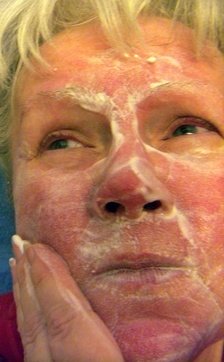Rosacea Skin Condition
Rosacea-Identify,Treatments and Tips
A rosacea skin condition can be difficult to identify especially in its early stages. A facial irritation can resemble acne or simply a flush or burn. Identifying the disease is very important for successful control and treatment.
 RECOGNIZE AND TREAT ROSACEA
RECOGNIZE AND TREAT ROSACEATo help treat and control this inflammatory disease it’s best to begin with identifying the condition. Many people are unfamiliar with rosacea symptoms and do not recognize it in its early stages because it can share a number of characteristics of other similar conditions.
It can be mistaken for acne types, lupus, psoriasis, eczema, or skin types that have broken or dilated capillaries (Couperose).
Early diagnosis and a dermatologists suggested treatments is the key to successful control of this facial skin disorder.
Rosacea Skin Condition Symptoms
The beginning rosacea signs are different for each individual. It may begin as “blushing” or cause redness to the face, nose, cheeks, and forehead. It may come and go and show similar signs of acne and acne- prone skin. Sometimes burning, itching, and eye sensitivity may accompany some cases.
This disorder may progress to a more persistent redness, become
more intense, have facial swelling that may affect the eye area, and visible broken blood vessels may
appear.
Left untreated, rosacea usually advances into more serious problems. It can lead to disfigurement that often occurs mainly on the nose, where the skin will thicken, swell, develop excess tissue/ enlarged pores and cause a red, swollen appearance (Example-W.C. Fields).
This common inflammatory disease is sometimes hard to self-diagnosis and may need the direction of a doctor for success and proper treatment.
Rosacea Skin Condition - Triggers
Be-aware of known triggers that makes your condition flair up
Triggers are anything that may cause a flare-up to the face making rosacea worse. Triggers can be brought on by the elements such as sun and wind, hot weather, or simply, temperature changes.
Other common triggers include –
Foods that are hot or spicy
Stress
Alcohol or hot drinks
Hot showers or baths
Anxiety
Heavy exercise
Drugs
Medical conditions
Beauty/Skin care products
Allergies
Avoidance of any known triggers will also help manage rosacea together with medical therapy. Keep a journal of potential triggers and the reaction you had.
Rosacea Treatments
In combination with a good skin care regimen, cosmetics to camouflage the problem, lifestyle and environmental care, and numerous treatments directed by a physician, this disorder can be controlled.
Prescribed medications, topical therapys, oral antibiotics, laser, or other surgical procedures are some methods of treatment.
Rosacea -Causes
The cause of rosacea is still unknown. It tends to affect adults with fair complexions. Women may be at a higher risk for the disorder although men generally suffer more severe symptoms.
It is not life-threatening but it can affect your appearance, cause you embarrassment, social problems, and lower your self-esteem. Usually you don’t out-grow this chronic disorder of flare-ups and remissions that become increasingly worse if left untreated.
Rosacea is not curable but it can be managed on a long-term basis successfully. Fortunately, once diagnosed, it’s quite treatable.
To comply with an rosacea solutions therapy plan and strict avoidance of your individual triggering factors is your best defense to cope and control a rosacea skin condition
Home › Facial Acne(Acne/Oily Skin) › ROSACEA SKIN CONDITION

